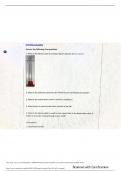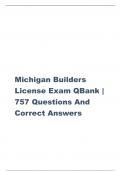Descriptive Statistics & Hypothesis
Testing
Descriptive statistics - correct answer ✔✔describes how the collected data appears both visually and in
numerical form
Statistics - correct answer ✔✔sample characteristics because they characterize some specific feature of
a data sample
Pie Chart - correct answer ✔✔visually shows what proportion of the total circle is represented.
Bar Chart - correct answer ✔✔visually shows how 2 or more groups compare across several categories
Frequency Tables - correct answer ✔✔visually summarize the frequencies and percentages of data
visual representation of variable - correct answer ✔✔1. pie charts
2. bar charts
3. frequency tables
Univariate analysis - correct answer ✔✔analysis involves the examination across cases of one variable at
a time. There are three major characteristics of a single variable that we tend to look at:
the distribution
the central tendency
the dispersion
In most situations, we would describe all three of these characteristics for each of the variables in our
study.
Distribution - correct answer ✔✔a summary of the frequency of individual values or ranges of values for
a variable. The simplest distribution would list every value of a variable and the number of persons who
, had each value. For instance, a typical way to describe the distribution of college students is by year in
college, listing the number or percent of students at each of the four years. Or, we describe gender by
listing the number or percent of males and females. In these cases, the variable has few enough values
that we can list each one and summarize how many sample cases had the value. But what do we do for a
variable like income or GPA? With these variables there can be a large number of possible values, with
relatively few people having each one. In this case, we group the raw scores into categories according to
ranges of values. For instance, we might look at GPA according to the letter grade ranges. Or, we might
group income into four or five ranges of income values.
Central Tendency - correct answer ✔✔an estimate of the "center" of a distribution of values. There are
three major types of estimates of central tendency:
mean, median, mode
Finding the Mean - correct answer ✔✔probably the most commonly used method of describing central
tendency. To compute the mean all you do is add up all the values and divide by the number of values.
For example, the mean or average quiz score is determined by summing all the scores and dividing by
the number of students taking the exam. For example, consider the test score values:
15, 20, 21, 20, 36, 15, 25, 15
The sum of these 8 values is 167, so the mean is 167/8 = 20.875.
The median - correct answer ✔✔is the score found at the exact middle of the set of values. One way to
compute the median is to list all scores in numerical order, and then locate the score in the center of the
sample. For example, if there are 500 scores in the list, score #250 would be the median. If we order the
8 scores shown above, we would get:
15,15,15,20,20,21,25,36
There are 8 scores and score #4 and #5 represent the halfway point. Since both of these scores are 20,
the median is 20. If the two middle scores had different values, you would have to interpolate to
determine the median.
The mode - correct answer ✔✔the most frequently occurring value in the set of scores. To determine
the mode, you might again order the scores as shown above, and then count each one. The most
frequently occurring value is the mode. In our example, the value 15 occurs three times and is the mode.
In some distributions there is more than one modal value. For instance, in a bimodal distribution there
are two values that occur most frequently.
15,15,15,20,20,21,25,36




